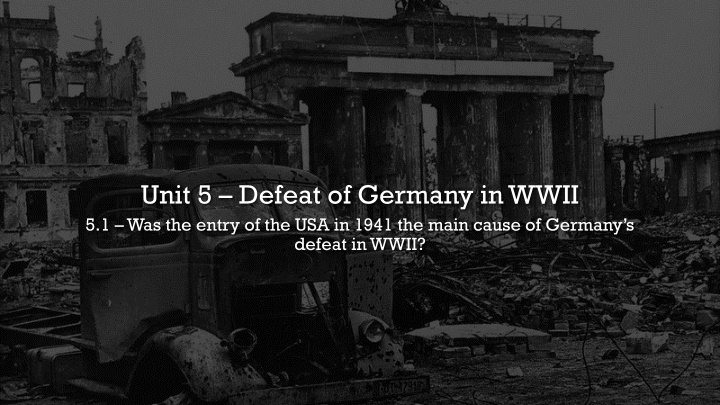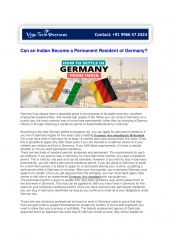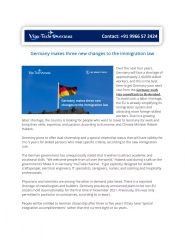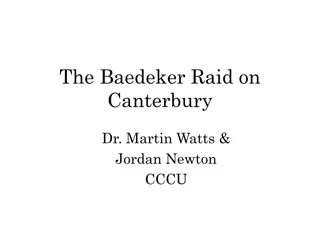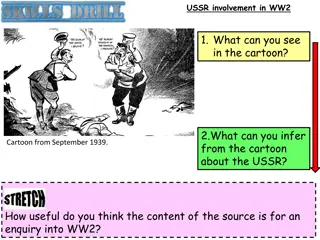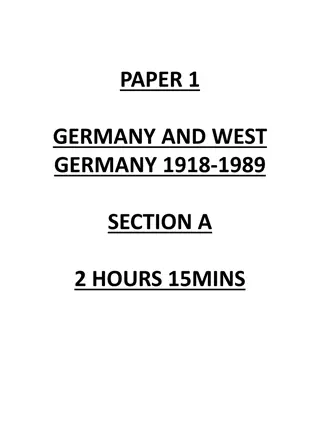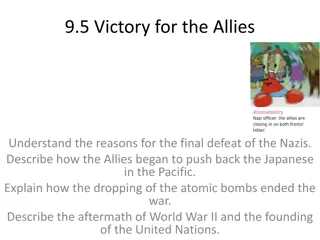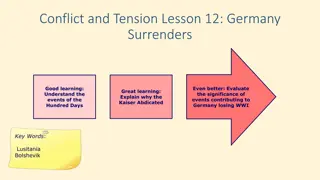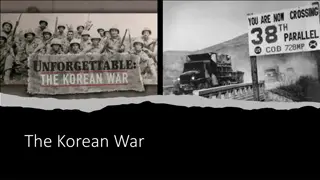Causes of Germany's Defeat in WWII
The entry of the USA in 1941 was a significant factor in Germany's defeat in WWII. Explore the reasons behind this, including USA's isolationism, indirect and formal involvement, vast contribution of resources, and collaboration with Allies on military strategies. Discover how these elements played a crucial role in shaping the outcome of the war.
Download Presentation

Please find below an Image/Link to download the presentation.
The content on the website is provided AS IS for your information and personal use only. It may not be sold, licensed, or shared on other websites without obtaining consent from the author.If you encounter any issues during the download, it is possible that the publisher has removed the file from their server.
You are allowed to download the files provided on this website for personal or commercial use, subject to the condition that they are used lawfully. All files are the property of their respective owners.
The content on the website is provided AS IS for your information and personal use only. It may not be sold, licensed, or shared on other websites without obtaining consent from the author.
E N D
Presentation Transcript
Unit 5 Defeat of Germany in WWII 5.1 Was the entry of the USA in 1941 the main cause of Germany s defeat in WWII?
Reasons for Germanys Defeat in WWII Entry of the USA Germany s weaknesses and miscalculations Allied resistance (not in syllabus)
Entry of the USA Isolationism Isolationist policy since the implementation of the Treaty of Versailles. Despite escalating tensions in Europe, USA remained an isolationist. Involves USA President Franklin Delano Roosevelt (F.D.R.). US President Franklin Roosevelt
Entry of the USA Indirect Involvement Cash and Carry (21st Sept 1939) Britain and France could buy goods if they paid and transported them on their own. Immediate, in full, and in cash. American commercial ships forbidden to enter conflict zones. Lend-Lease Act (11th March 1941) France fell in June 1940. Roosevelt had the authority to supply weapons, food and equipment to any country whose defence was considered vital to the national security of USA. Payment could be deferred and not in cash. Destroyers for Bases Agreement (2nd Sept 1940) After France fell to Germany, USA gave Britain 50 old destroyers. Britain got back 8 naval bases in the Caribbean, an area near the USA. Signalled USA s increased involvement to the Axis Powers, prompting a Tripartite Pact.
Entry of the USA Formal Involvement Japan s attack on the United States Pearl Harbour on 7th December 1941 led to the trigger of USA being formally involved in WWII.
Entry of the USA Formal Involvement (Contribution of Vast Resources and Manpower) In 1941, the USA was the largest producer of goods and was able to convert its factories for military production at a faster rate than any of the Axis Powers. US involvement in WWII also led to the USA contributing large numbers of American military personnel to aid Allied military operations. This helped to support Allies and push back against the Germans at the war front.
Entry of the USA Formal Involvement (Collaboration with Allies on Military Strategies) The formal entry of the USA into WWII saw direct US participation in the planning and execution of Allied military strategies such as D-Day landings was instrumental in contributing to the Allied victory. US collaboration with the Allies on military strategies was also crucial in helping the Allies win control of the air and the sea. This resulted in a reduction in German military might, weakening Germany s war effort.
Germanys Weaknesses and Miscalculations Ineffective Command Structure The German army was a system of overlapping authority. Hitler, as the supreme decision maker, was the only one to have access to all information. He did not listen to generals and failed to capitalize on opportunities.
Germanys Weaknesses and Miscalculations Inappropriate Use of Resources and Military Funds German military leaders competed for funds to strengthen their own sections of the German defence forces. Hitler constantly demanded for the most up-to-date weaponry, resulting in the mass production of some weapons that were not even tested on the battlefield or proved to be effective. Unlike the Allies who focused on producing a few types of proven weapons and equipment, Germany focused on producing a large number of different types of armament, meaning that they needed many different spare parts. This put Germany at a big disadvantage as it could not match the Allies production of war goods.
Germanys Weaknesses and Miscalculations Heavy Reliance on Petroleum Germany had little natural petroleum reserves, synthetic oil was used as a possible substitute. Germany used oilfields in Nazi-occupied countries but these were later put out of operation by Allied forces. The loss of Ploesti oilfields in Romania drastically affected Germany. Petroleum was used for fueling the tanks and powering the factories.
Germanys Weaknesses and Miscalculations War on Two Fronts While still at war with Britain on the Western Front, Hitler made the costly mistake of invading the USSR, opening up the Eastern Front. This tactical error of deciding to fight on both fronts thinned out Germany s resources and prevented Hitler from concentrating his efforts on a single theatre of war and fighting a decisive war in a single theatre. This made it difficult to secure victory against the Allies and weakened Germany s military operations.
